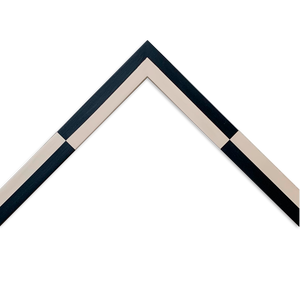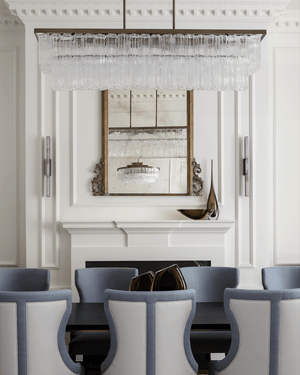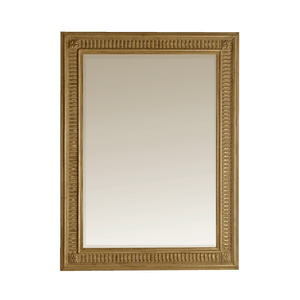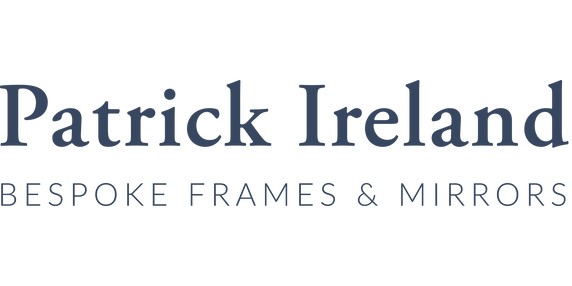Frame and Mirror Glossary
Like all trades, framing has its own vernacular and vocabulary. We've put together a glossary of some of the terms you'll hear in conversation with us and find throughout the site below, but if there's anything you don't see or if you have any additional questions, please don't hesitate to get in touch.
A
ANTI-REFLECTIVE GLASS
Special glass with anti-reflective properties to reduce light and shadow reflection.
Tip: There are different qualities of anti-reflective glass, please ask if you need advice.
ATD
ATD stands for anti-theft device. Typically ATDs are used on frames in commercial properties, such as hotels, as they require a special key to take the frames off the wall.
C
CLOSE FRAMED
Close Framed, or Full Bleed, is when the artwork is framed to the edge of the paper without the addition of a mount. The edges of the artwork sit behind the frames’ rebate. Click here to view an example.
D
DOUBLE MOUNT
When two mounts are used, one on top of the other. The upper mount is narrower, revealing the mount underneath.
Tip: Use different colour mounts to introduce colour or additional interest to the framed piece. Click here to view an example.
DRY MOUNTING
Dry mounting is a process in which a print is bonded to a mount using an archival adhesive. It can be a good way to flatten and display artwork.
Tip: We can advise if artwork needs dry mounting once we have the artwork at the workshop. Depending on the artwork, we will either do this at the workshop or send it away to one of our trusted suppliers for dry mounting.
E
EGLOMISE
Eglomise is the French word for 'gilded glass' and is when the back of a piece of glass is gilded in gold leaf. Click here to view examples.
F
FILLET/SPACER
An optional inner frame that sits within the rebate to create space between the glass and the artwork. Typically used in box frames, they can vary in depth. The fillet is not visible when looking at the frame face-on. Click here to view an example.
Tip: Wrap the fillet in fabric or paint it in a different colour to add a subtle pop of texture or colour to the framed piece.
FRAME DEPTH
The overall dimension from the face of the frame to the back of the frame.
FRAME PROFILE
Refers to the shape of the moulding.
Tip: We display our frame profiles as cross sections so you can see the overall shape of the moulding.
FRAME WIDTH
The visible width of the face of the frame.
G
GILVER
Gilver is a bespoke colour we created by mixing silver and gold, hence the gilver!
H
HOCKEY
Hockey is a term applied to frames that have a cross section that looks similar to a field hockey stick. Take a look at our Friston or Friston Mini frame profiles for examples of hockey frames.
M
MITRED CORNER
The mitred corner is where the frame profile lengths are cut at 45-degree angles and joined to make the frame.
Tip: We use gesso (primer) on the majority of our finishes to hide the mitred corners. This allows our frames to have a smooth, uninterrupted finish around the frame. Mitres are only visible on timber finishes, such as a limed, waxed or stained timber.
MOULDING
The length of timber which is cut down and joined to make the frame.
MOUNT OPENING
The cut inner edge of the mount which opens up to reveal the artwork.
Tip: The mount width is the dimension between the inside edge of the mount and the outer edge which sits under the rebate.
MOUNT/MAT/PASSEPARTOUT
A piece of board which is cut and used as a border around a piece of artwork. The mount can be used to stop the artwork from touching the glass, as a decorative addition to the frame and is also a good way of increasing the overall size of the framed artwork. It can be made as wide or as narrow as you would like, and also can vary in thickness.
Tip: All mounts we use are conservation mounts (ph balanced), which means they are acid free and will not damage the artwork over time.
R
REBATE
The cut in the moulding behind the face of the frame which keeps the frame components, including the glass, mount and backboard, in place.
S
SHADOW GAP
The space/gap between the artwork and the frame - generally referred to when the artwork is framed in a tray frame, or floated on board.
Tip: Paint the shadow gap a different colour to the frame.
SIGHT EDGE
The inside vertical edge of the frame between the frame face and the rebate.
Tip: A deeper sight edge can add depth to the overall framed piece and can be finished in a different colour.
SLIP
A slip is a decorative inner frame, often with a bevel or other decorative detail. It can sit between the frame and the glass, or between the glass and the artwork.
Tip: Finish the slip in a different finish to the main frame.
SPLIT BATTEN
A hanging system we often use for mirrors. One half of the timber batten is fixed on the back of the frame during production and the other half is screwed onto the wall at the hanging stage. Each batten has an angled face which self-mates and draws the frame flush to the wall. Another advantage of using a split batten is that it spreads the weight of the mirror across the width of the batten.
Tip: See diagram

T
TRAY OR FLOAT FRAME
Typically used to frame artwork on a canvas or on a board. A tray frame has no rebate, so the artwork is placed into the frame from the front, just like a tray! Click here to view examples.
U
UV GLASS
Special glass with a UV protective barrier to reduce possible light damage to a piece of art.
Tip: Levels of UV protection vary between glass types and brands, so please ask if you need advice.
W
WASHLINE MOUNT
Also known as wash and line mounts, these traditional style mounts are drawn by hand to complement the colours of the picture. Once a very popular style of mount used with watercolours, the washline mount seems to be making a comeback.

Frame Profiles
We’ll help you choose the right frame profile from our extensive collection, which features everything from slim, contemporary frames to more imposing, ornate options.

Portfolio
We have the pleasure of working with some of the best names in interiors. Our portfolio showcases a selection of framed art and mirrors we've made for customers over the years.

The Sussex Collection
Expertly conceived and hand-crafted by the team in our workshop, our mirrors can be bought as they are, customised, or simply used to inspire.
